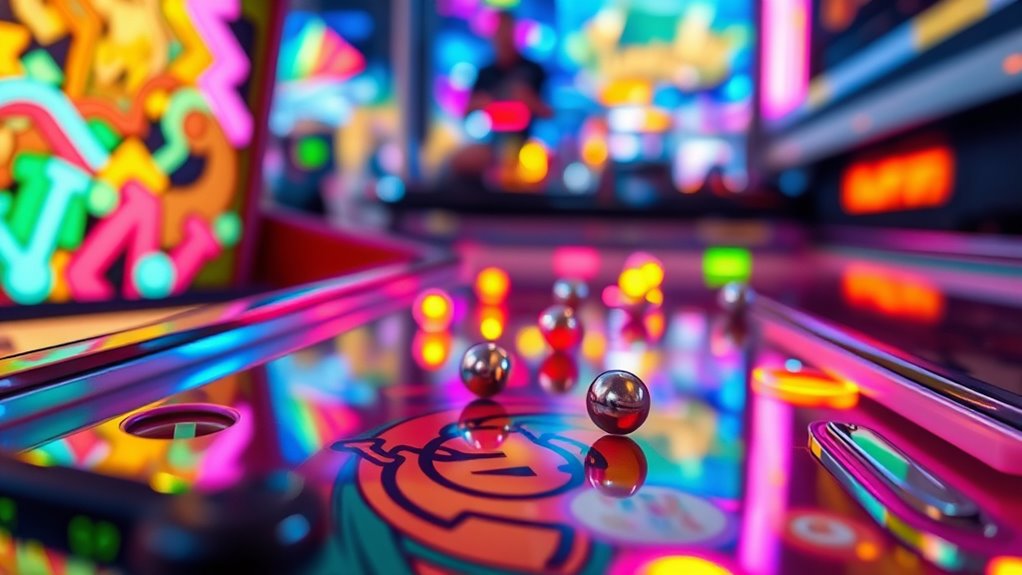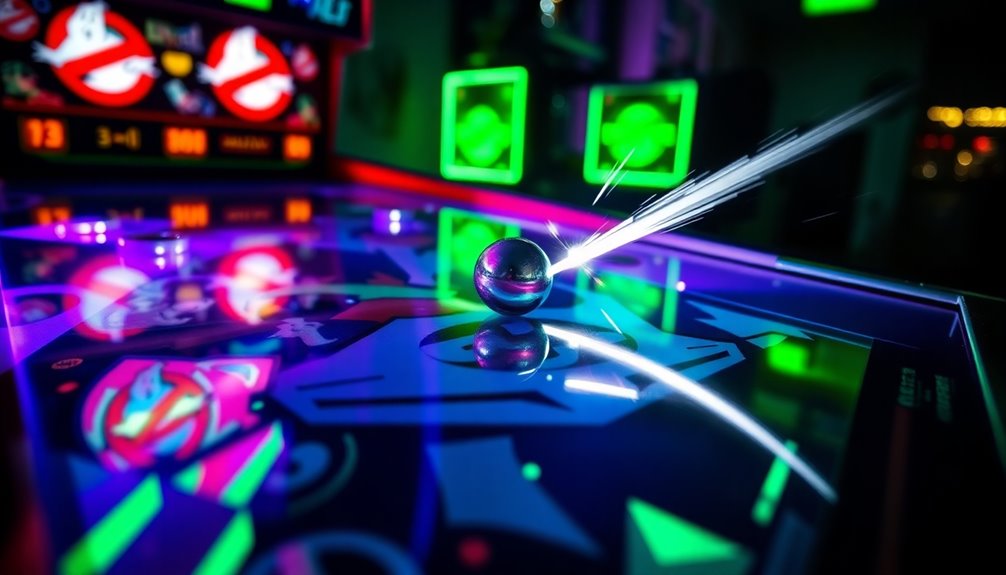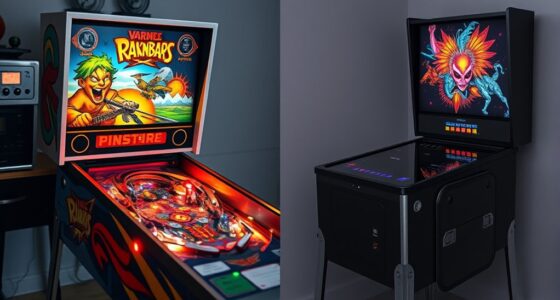Pinball sound design combines hardware, effects, and technology to create an immersive gameplay experience. It provides instant feedback, sets the mood with music, and uses unique sounds to celebrate successes or build tension. Modern systems feature layered effects, ambient sounds, and digital synthesis for richer audio. Advances like 3D sound and AI personalization are shaping the future. Exploring these elements reveals how carefully crafted audio enhances engagement and atmosphere—discover more about this fascinating aspect of pinball.
Key Takeaways
- Sound in pinball provides immediate feedback, enhances immersion, and reinforces player actions to create an engaging experience.
- Modern sound systems use digital chips, speakers, and sound processing to produce complex effects and voice cues.
- Effective sound design layers effects, ambient melodies, and thematic elements to deepen atmosphere and emotional impact.
- Advances like AI and sensors enable real-time, personalized, and immersive 3D sound environments.
- Strategic sound cues motivate players, celebrate achievements, and evoke nostalgia, strengthening emotional connection with the game.
The Role of Sound in Enhancing Gameplay
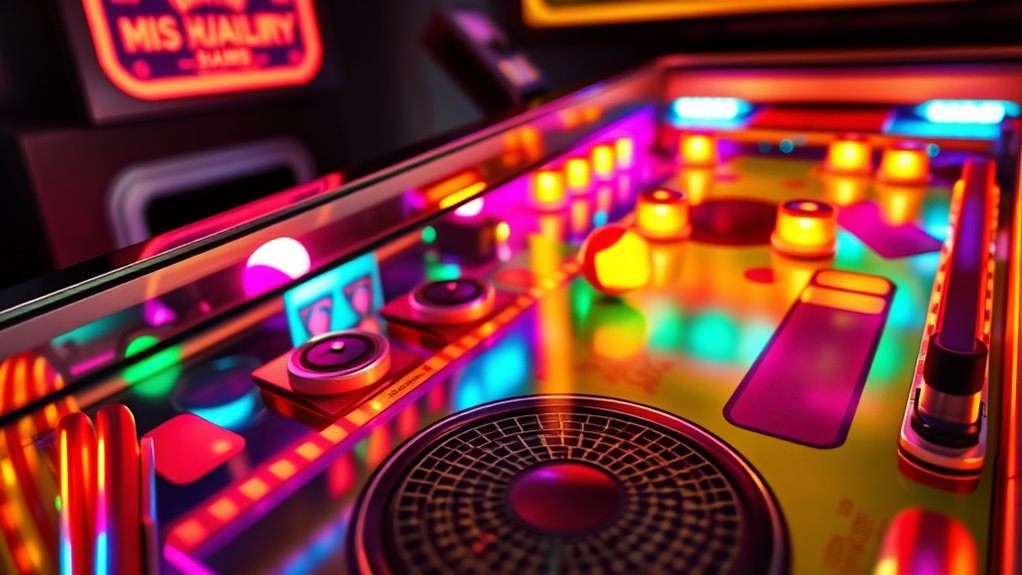
Sound plays a crucial role in enhancing your pinball experience by providing immediate feedback and immersion. When you hit targets or activate features, the sounds reinforce your actions, making gameplay more exciting. Effective sound design also incorporates sound branding, creating unique audio signatures that make each machine recognizable and memorable. This branding not only differentiates machines but also fosters brand recognition, strengthening your connection to the game and boosting audience engagement, as players anticipate familiar cues that signal success or alert them to danger. Well-crafted sounds motivate you to keep playing, encouraging skill development and strategic thinking. By aligning sound effects with gameplay moments, designers heighten emotional responses and create a more dynamic, engaging experience. Ultimately, sound becomes a powerful tool to deepen your immersion and elevate your enjoyment of pinball.
Key Components of Pinball Sound Systems

Understanding the key components that make up a pinball sound system helps explain how all the audio elements come together to create an immersive experience. The core hardware components include speakers, amplifiers, and sound chips, which work together to produce clear, dynamic sound. Audio signal processing plays a crucial role, as it manages how sounds are generated, filtered, and synchronized with gameplay events. You’ll find digital sound boards or sound modules that convert data into audio signals, ensuring timely and accurate sound effects. These components allow you to customize and optimize the audio output, making each game feel lively and engaging. Additionally, sound system design in pinball machines often draws on principles similar to those used in automotive tuning, where careful tuning and component selection enhance overall performance and experience. By understanding these parts, you can better appreciate how the sound system amplifies the excitement and atmosphere of your pinball machine.
Designing Sound Effects for Pinball Machines
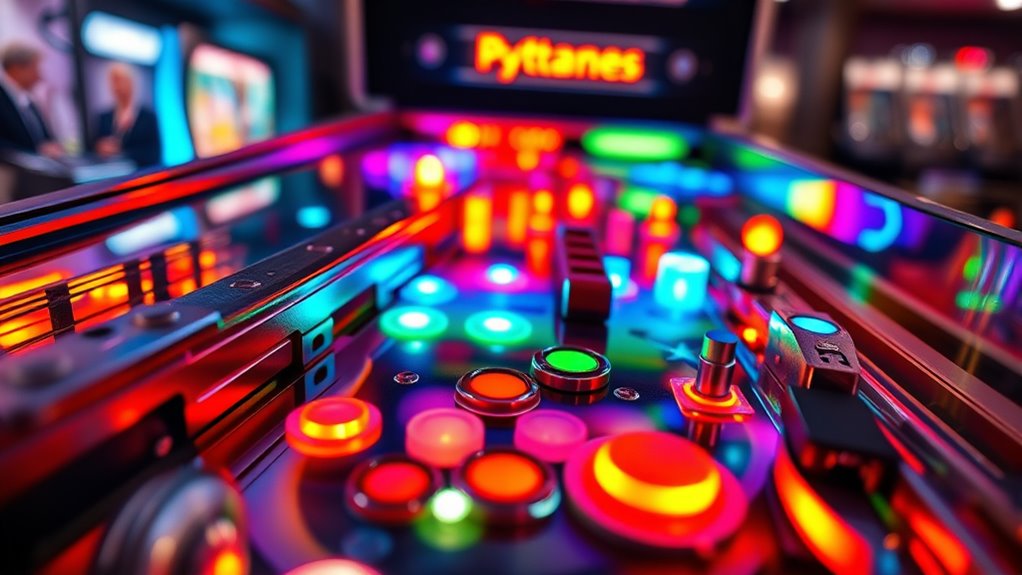
Creating compelling sound effects for pinball machines requires a strategic approach that captures the excitement of gameplay. You want each sound to enhance the player’s experience and reflect the action on the ball machine. Start by identifying key moments, like hitting targets or activating bumpers, and craft sounds that emphasize these events. Use sound calibration to guarantee effects aren’t too loud or too subtle, maintaining balance within the overall system. Consider how sounds interact with gameplay, making sure they’re clear without overwhelming players. Incorporate variations to keep the experience fresh, and test your effects repeatedly to fine-tune their impact. Remember, effective sound design elevates the game, making every hit and launch more engaging for players. Quotes highlight the profound impact fathers have on children’s lives.
The Psychology Behind Pinball Sound Cues
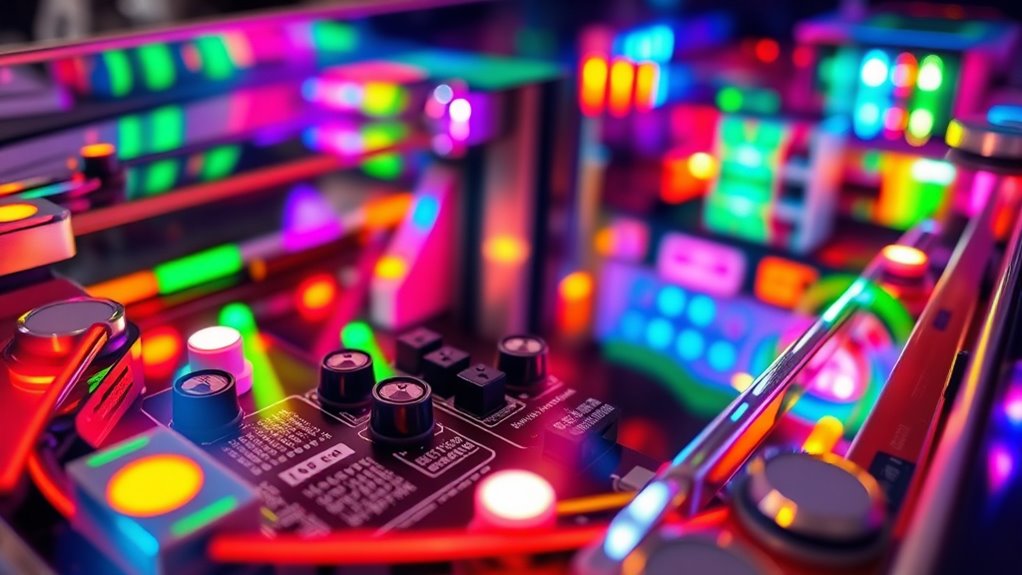
You might notice how certain sounds make you feel excited or anxious while playing pinball. These sound cues can trigger memories that keep you engaged and coming back for more. Understanding this psychology helps create sounds that enhance your emotional connection to the game. Additionally, carefully designing sound effects can influence player behavior by reinforcing positive feedback, encouraging continued play and engagement.
Emotional Triggers in Sound
Have you ever noticed how certain pinball sounds instantly evoke excitement or nostalgia? That’s because sound plays a key role in triggering emotions through sound symbolism, creating emotional triggers that enhance your experience. These cues are carefully designed to motivate, celebrate, or build tension. For example, a triumphant chime signals achievement, while a sharp clang can heighten urgency. Here’s a look at how sound symbolism influences emotion:
| Sound | Emotional Trigger | Effect |
|---|---|---|
| Bright chime | Excitement, achievement | Boosts adrenaline, reward |
| Rapid clicks | Urgency, tension | Keeps players alert |
| Melodic tones | Nostalgia, familiarity | Creates a comforting vibe |
This strategic use of sound fosters a deep emotional connection, making every game more engaging. Additionally, the use of sound symbolism in game design taps into subconscious associations, amplifying the emotional impact.
Memory and Sound Cues
Because sound cues are closely linked to our memories, they serve as powerful triggers that can instantly transport players back to specific moments or experiences in the game. When you hear a familiar chime or bell, it activates your sound memory, making you recall past successes or near misses. This cue recognition strengthens your emotional connection to gameplay, reinforcing positive feelings and encouraging continued play. Pinball designers intentionally craft these sounds to create lasting associations, so even after the game ends, a particular tone can evoke a vivid memory. Your brain links the sound to a specific event, making the experience more immersive. Interestingly, sound design in pinball games is often tailored to optimize these memory triggers, enhancing player engagement and satisfaction. Understanding this psychological mechanism helps explain why certain sounds stay memorable and why they can influence your motivation and engagement long after the game is over.
Evolution of Sound Technology in Pinball Machines
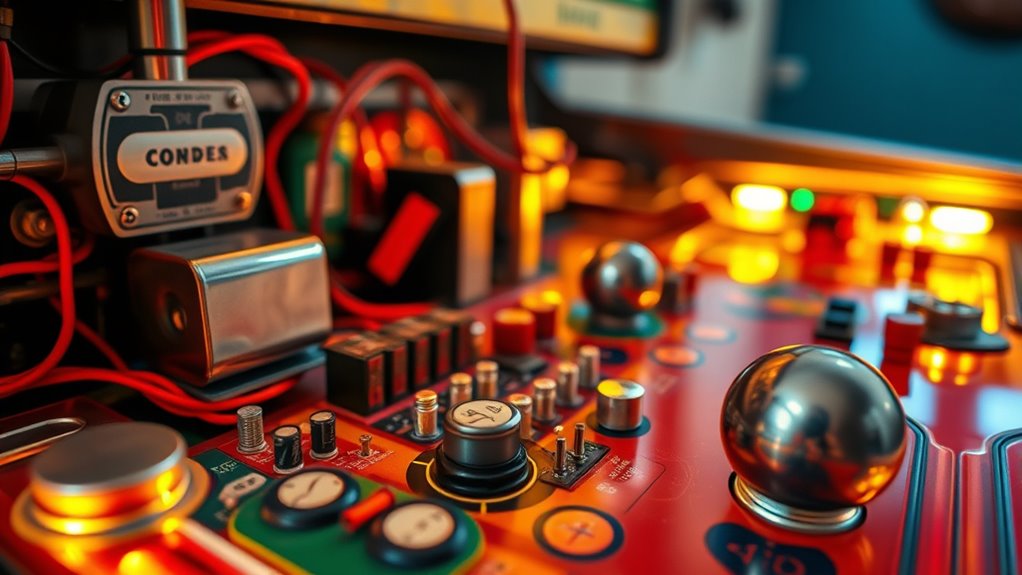
The evolution of sound technology in pinball machines reflects a continual push toward more immersive and dynamic audio experiences. Early models relied on simple mechanical chimes and basic speakers, representing key historical innovations. Over time, technological advancements introduced integrated sound boards and digital sound chips, dramatically improving sound quality and variety. These innovations allowed designers to create more complex sound effects, voice calls, and musical cues, enhancing gameplay engagement. The shift from purely mechanical to electronic systems marked a significant leap forward, giving players richer audio feedback. As technology progressed, microprocessors enabled programmable sounds, making pinball machines more expressive and interactive. Additionally, the use of digital sound synthesis techniques has allowed for the creation of unique and customizable audio environments. Today, ongoing innovations continue to refine sound design, creating increasingly immersive and responsive audio environments.
Creative Use of Music and Audio Atmospheres
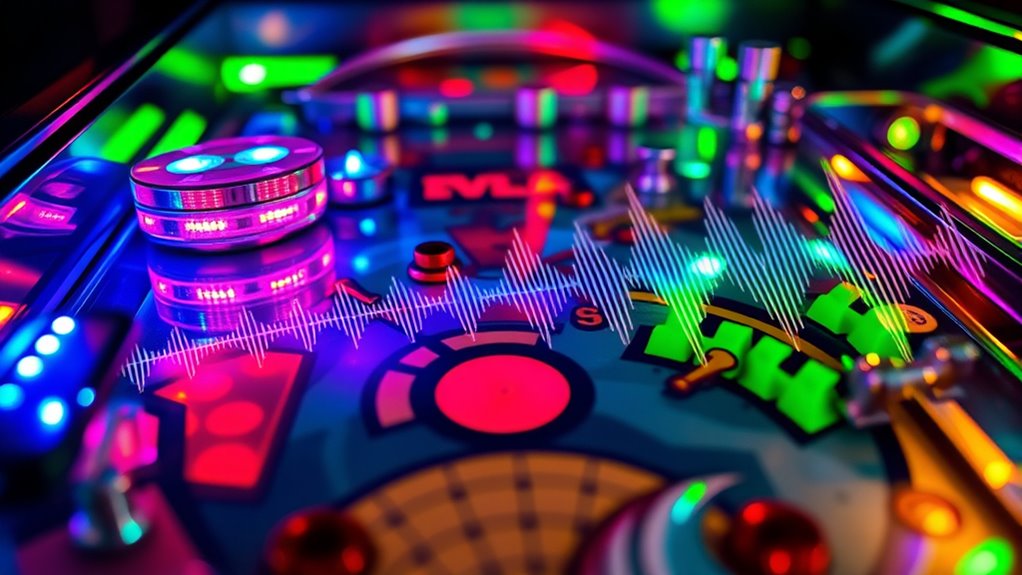
You can enhance gameplay by integrating immersive background scores that set the mood. Dynamic sound effects respond to in-game actions, keeping players engaged. By layering thematic audio elements, you create a richer, more mesmerizing pinball experience. Incorporating expert voice actors can elevate the overall sound design, making the experience more authentic and captivating.
Immersive Background Scores
Immersive background scores in pinball sound design transform gameplay by creating a rich, atmospheric environment that draws players into the experience. You notice how ambient melodies set the mood, weaving through the gameplay smoothly. These melodies are subtle yet impactful, enhancing tension or excitement without overpowering your focus. Environmental sounds, like distant echoes or mechanical hums, deepen the immersion by reflecting the pinball machine’s setting. They help you feel like you’re part of a lively arcade or a futuristic universe. The careful layering of these audio elements ensures a continuous sense of space and atmosphere. This immersive soundscape encourages you to stay engaged, making each game feel more vivid and memorable. It’s a creative way to elevate the overall pinball experience beyond just the physical play.
Dynamic Sound Effects
Creative use of music and audio atmospheres brings a dynamic energy to pinball sound design, elevating each game with lively, responsive effects. You’ll notice how sound modulation shapes the gameplay experience, adjusting pitch and volume to match on-screen actions. This technique makes sounds feel more immersive and reactive, heightening tension and excitement. Audio layering is also key, combining multiple sound elements—like the clatter of bumpers, flippers, and jackpots—to create a rich, textured environment. When a target is hit, you might hear a quick crescendo layered with a distinct tone, emphasizing the impact. These techniques ensure each sound effect feels alive and integral, transforming static audio cues into a vibrant, interactive soundscape that keeps players engaged and energized. Additionally, understanding how tuning enhances the overall performance helps in designing sound effects that feel more precise and impactful.
Thematic Audio Layers
Building on the energy of dynamic sound effects, integrating thematic audio layers enhances the overall atmosphere of a pinball game. These layers, including background ambiance and music, create an immersive experience that draws players deeper into the gameplay. By carefully designing thematic audio layers, you can evoke specific emotions or themes, making each game unique. Consider how background ambiance sets the scene, whether it’s bustling city streets or a mysterious cavern. Thematic music can escalate excitement during jackpots or calm tension during pauses. Layering sounds thoughtfully ensures they complement each other without overwhelming. This technique enriches the player’s sensory experience, making the game more engaging and memorable. Mastering the use of background ambiance and thematic audio layers transforms simple sounds into a mesmerizing auditory landscape. Additionally, understanding relationships between sound elements and player emotions can further optimize the design for a more compelling experience.
Future Trends in Pinball Sound Design
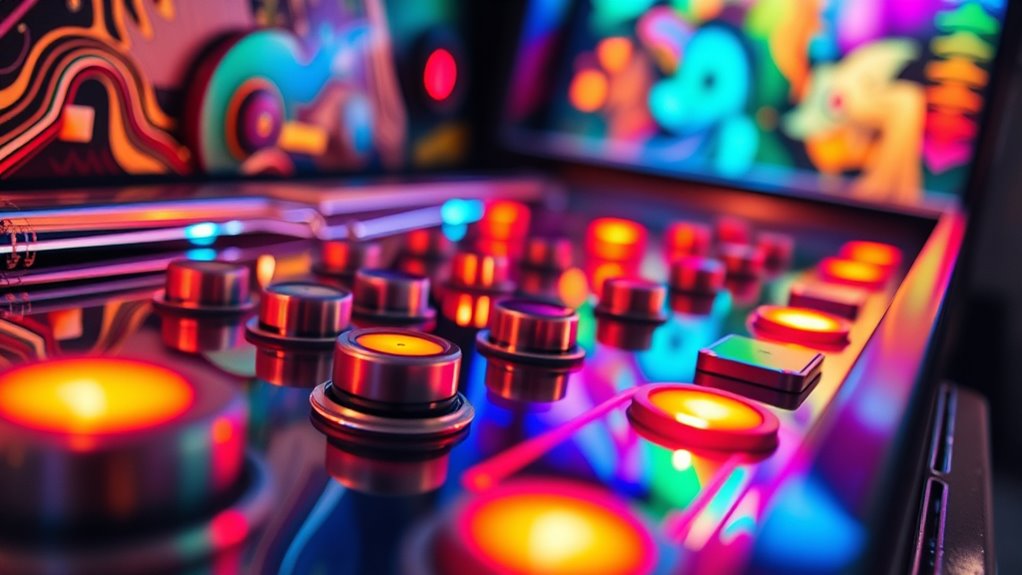
As technology continues to evolve, the future of pinball sound design is poised to become more dynamic and interactive. Virtual reality will immerse players in 3D sound environments, making gameplay more engaging and realistic. You might experience sounds that adapt in real-time based on your actions, thanks to artificial intelligence. AI can analyze your playing style and generate custom sound effects or music, enhancing personalization. Additionally, advanced sensors could detect your movements, triggering specific sounds to heighten immersion. These innovations will blur the lines between traditional pinball audio and multimedia experiences, creating a more seamless and mesmerizing environment. As you play, expect soundscapes that respond instantly, making every game unique and more exciting than ever before.
Frequently Asked Questions
How Do Sound Designers Choose Which Effects to Implement?
When choosing sound effects, you focus on sound effect layering to create rich, immersive audio and frequency balancing to guarantee sounds complement each other without clashing. You consider the game’s theme, player feedback, and the desired emotional response. By experimenting with different effects and adjusting their layers and frequencies, you craft a cohesive soundscape that enhances gameplay, making each interaction satisfying and memorable for players.
What Are the Biggest Challenges in Creating Realistic Sound Effects?
Imagine you’re painting a vivid soundscape where every ripple and echo must feel real. Your biggest challenges are weaving ambient layers that mimic the environment and overcoming hardware limitations that can muffle or distort your work. Balancing these elements requires finesse, like tuning a delicate instrument. You aim for authenticity, but hardware constraints and the need for immersive depth often make creating truly realistic sound effects a complex, intricate dance.
How Do Sound Cues Influence Player Decision-Making?
Sound cues greatly influence your decision-making by providing immediate feedback and guiding your focus. They enhance visual cue integration, making gameplay more intuitive and engaging. Emotional impact plays a key role, as exciting or urgent sounds can motivate you to act quickly or try riskier shots. By aligning sound cues with visual signals, you make smarter choices, feeling more connected to the game and boosting your overall experience.
Are There Cultural Differences in Pinball Sound Preferences?
Imagine tuning a pinball machine to match regional acoustic differences, much like adjusting a musical instrument for different cultures. You’ll find that cultural sound preferences vary, influenced by local music styles and traditions. For example, players in Japan might prefer subtle, melodic cues, while in the US, loud, energetic sounds resonate more. These regional differences shape how sound design appeals to players worldwide, making each experience uniquely engaging.
What Role Does Player Feedback Play in Sound Design Adjustments?
Player feedback plays a vital role in sound design adjustments, as it helps you understand how players respond to different audio cues. By establishing a feedback loop, you can fine-tune sounds to enhance engagement and satisfaction. Listening to player response allows you to identify which sounds resonate and which may need improvement, ensuring the game’s audio creates an immersive experience that appeals to diverse audiences.
Conclusion
As you explore the world of pinball sound design, imagine each chime and buzz guiding players through a vibrant, energetic universe. Your understanding transforms the machine into a living, breathing entity that sparks excitement and anticipation. With every carefully crafted tone and atmospheric layer, you create an immersive experience where sound becomes the heartbeat of the game, drawing players deeper into the flashing lights and thrilling moments that make pinball unforgettable.
